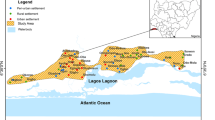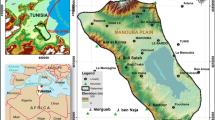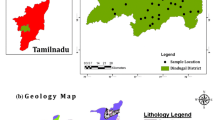Abstract
In arid areas, groundwater quality is an important concern for human life and natural ecosystems. Rapid economic development impacts greatly on limited groundwater resources. This study examines the impacts of natural and anthropogenic contaminations on groundwater quality by integrating hydrochemical investigations, GIS and multivariate geostatistical techniques. Major and trace elements in groundwater were analyzed to evaluate the shallow alluvial aquifer connected to the fractured basement aquifer in the Jazan area of Saudi Arabia (KSA). Results show that the groundwater of the aquifer inland is generally under free conditions and is declining with time, while in the coastal areas, there is a disturbance of the groundwater balance resulting in upward leakage of deep saline water and seawater intrusion. Groundwater types are varied from calcium bicarbonate to sodium chloride, reflecting meteoric water recharge to seawater influence. The pollution risk is high, since the water table is shallow and the aquifers are highly permeable. Urbanization has put stress on groundwater quality due to wastewater contamination from pit latrines and leakage from the unrehabilitated sewage system. Chemical equilibrium and saturation indices were calculated, showing that most of the water samples were under-saturated with respect to anhydrate, aragonite, calcite, dolomite, gypsum and halite mineral phases. This affects carbonate and evaporite minerals in the aquifer, causing ground subsidence and sinkholes in the coastal area. Factor and cluster analyses were used to classify and examine the processes affecting groundwater quality. The main factors impacting on the groundwater hydrochemistry were identified as: dissolution of several minerals, evaporation, human impact, mixing between geothermal and other waters as well as rainfall recharge.










Similar content being viewed by others
References
Adams S, Titus R, Pietersen K, Harris G (2001) Hydrochemical characteristics of aquifers near Sutherland in the Western Karoo, South Africa. J Hydrol 241(1–2):91–103
Alabdula’aly A, Al-Rehaili A, Al-Zarah A, Khan M (2010) Assessment of nitrate concentration in groundwater in Saudi Arabia. Environ Monit Assess 161(1–4):1–9
Al-Amri A (1998) The application of geoelectrical vertical soundings in delineating the hydrostratigraphy of the southern Red Sea coastal area, Saudi Arabia. J King Abdul Aziz Univ 10:73–90
Al-Bassam A, Hussein M (2008) Combined geo-electrical and hydrochemical methods to detect salt water intrusions: a case study from southwestern Saudi Arabia. Manag Env Qual 19:179–193
Al-Sharif A (1984) Geography of Saudi Arabia. Part II, “The South-west of Saudi Arabia. Mars publications, Riyadh
Alshikh A (2011) Analysis of Heavy Metals and Organic Pollutants of Ground Water Samples of South Saudi. Life Sci J 8(4):438–441
Alther G (1979) A Simplified Statistical Sequence Applied to Routine Water Quality Analysis: A Case History. Ground Water 17:556–561
Assaf H, Saadeh M (2009) Geostatistical Assessment of Groundwater Nitrate Contamination with Reflection on DRASTIC Vulnerability Assessment: The Case of the Upper Litani Basin, Lebanon. Water Resour Manage 23:775–796
Babiker I, Mohamed M, Hiyama T (2007) Assessing groundwater quality using GIS. Water Resour Manag 21:699–715
Batayneh A, Elawadi E, Mogren S, Ibrahim E, Qaisy S (2012) Groundwater quality of the shallow alluvial aquifer of Wadi Jazan (Southwest Saudi Arabia) and its suitability for domestic and irrigation purpose. Sci Res Essays 7(3):352–364
Belkhiri L, Narany T (2015) Using Multivariate Statistical Analysis, Geostatistical Techniques and Structural Equation Modeling to Identify Spatial Variability of Groundwater Quality. Water Resour Manage 29:2073–2089
Bengraine K, Marahaba T (2003) Principal component analysis to monitor spatial and temporal changes in water quality. J Hazard Mat B100:179–195
Brown C (1998) Applied Multivariate Statistics in Geohydrology and Related Sciences. Springer, Berlin
Cattell R (1966) The scree test for the number of factors. Multivar Behav Res 1:245–276
Ceron J, Pulido-Bosch A, Bakalwicz M (1999) Application of principal components analysis to the study of CO2- rich thermomineral waters in the aquifer system of Alto Guadalentín (Spain). Hydrological Sci 44(6):929–942
Custodio E, Bruggeman F (1987) Groundwater Problems in Coastal Areas; Studies and Reports in Hydrology No. 45. UNESCO Publications, Belgium
Dalton M, Upchurch S (1978) Interpretation of Hydrochemical Facies by Factor Analyses. Ground Water 16:228–233
Davis J (2002) Statistics and Data Analysis in Geology. Wiley, New York
dos Santos J, de Oliveira E, Bruns R, Gennari R (2004) Evaluation of the salt accumulation process during inundation in water resource of Contas river basin (Bahia–Brazil) applying principal component analysis. Water Res 38:1579–1585
El Alfy M (2012) Integrated Geostatistics and GIS techniques for assessing groundwater contamination in Al-Arish area, Sinai, Egypt. Arab J Geosci 5(2):197–215
El Alfy M (2013) Hydrochemical modeling and assessment of groundwater contamination in Northwest Sinai, Egypt. Water Environ Res 85(3):211–223
El Alfy M, Merkel B (2006) Hydrochemical relationships and geochemical modeling of ground water in Al Arish area, North Sinai, Egypt. American Institute of Hydrology (AIH). Hydrological Sci Technol J 22(1–4):47–62
Eweida A (1992) Groundwater Hydrochemistry of Wadi El-Arish Delta, North Sinai. Proceedings of the 3rd Conference on Geololgy of Sinai for Development; Suez Canal University, Ismailia, Egypt
Fallatah A (1994) Report on some soils, a subsidiary of Jazan agricultural development sites. Jazan Agricultural Development Company, Jizan
Farnham I, Stetzenbach K, Singh A, Johannesson K (2000) Deciphering Groundwater Flow Systems in Oasis Valley, Nevada, Using Trace Element Geochemistry, Multivariate Statistics, and Geographical Information System. Math Geol 32:943–968
Freeze R, Cherry A (1979) Groundwater; Prentice-Hall: Upper Saddle River, New Jersey
Furi W, Razack M, Abiye T, Kebede S, Legesse D (2012) Hydrochemical characterization of complex volcanic aquifer in a continental rifted zone: the Middle Awash basin, Ethiopia. Hydrogeol J 20:385–400
Halim M, Sumayed M, Majumder K, Ahmed N, Rabbani A (2011) Study on groundwater, river water and tannery effluent quality in Southwestern Dhaka, Bangladesh: Insights from multivariate statistical analysis. J Natural Sci Sustainable Technol 5(3):125–147
Hussein M, Ibrahim K (1997) Electric resistivity, geochemical and hydrogeologyical of wadi deposits, Western Saudi Arabia. J King Abdul Aziz Univ 9:55–72
Jiang Y, Wu Y, Groves C, Yuan D, Kambesis P (2009) Natural and anthropogenic factors affecting the groundwater quality Nandong karst underground river system in Yunan, China. J Contam Hydrol 109:49–61
JICA (2010) The study on master plan on renewable water resources development in the southwest region in the Kingdom of Saudi Arabia. Ministry of Water and Electricity, final report, 294
Kaiser H (1958) The varimax criteria for analytical rotation in factor analysis. Psychometria 23:187–200
Lashin A, Al Arifi N (2014) Geothermal energy potential of southwestern of Saudi Arabia “exploration and possible power generation”: A case study at Al Khouba area- Jizan. Renewable Sustainable Energy Rev 30:771–789
Loska K, Wiechula D (2003) Application of principal component analysis for the estimation of source of heavy metal contamination in surface sediments from the Rybnik Reservoir. Chemosphere 51:723–733
MAW (1994) Atlas of Land Resources, Ministry of Agriculture and Water. Investment land management, Riyadh
Metwaly M, Elawadi E, Moustafa S, Al Arifi N, El Alfy M, Al Zaharani E (2014) Groundwater contamination assessment in the Al-Quwy’yia area of central Saudi Arabia using transient electromagnetic and 2D electrical resistivity tomography. Environ Earth Sci 71:827--835
Mogren S, Batayneh A, Elawadi E, Al-Bassam A, Ibrahim E, Qaisy S (2011) Aquifer boundaries explored by geoelectrical measurements in the Red Sea coastal plain of Jazan area, southwest Saudi Arabia. Int J Phys Sci 6:3768–3776
Munn R (1979) Environmental Impact Assessment: Principles and Procedures. Wiley, New York
National Center for Atmospheric Research (2008) Improve understanding of the atmosphere, earth system, and sun. Annual report, Research application Laboratory. http://www.nar.ucar.edu/2008/RAL/goal_1/priority_2.php
Parkurst D, Appelo C (2011) User’s Guide to PHREEQC (Version2)-A Computer Program for Speciation, Batch-Reaction, One-Dimensional Transport, and Inverse Geochemical Calculations. U.S. Department of the Interior/U.S. Geological Survey, Washington
Sanchez-Martoz F, Jime’nez E, Pulido B (2001) Mapping groundwater quality variables using PCA and geostatistics: a case study of Bajo Andarax, southeastern Spain. Hydrol Sci J 46(2):227–242
Sen Z (2008) Wadi Hydrology, Chapter 6. In: Groundwater management methods for arid regions (ed.). Taylor and Francis, London, pp 243–301
Shakeri A, Moore F, Mohammadi Z, Raesi E (2009) Heavy metal contamination in the Shiraz industrial complex zone groundwater, South Shiraz, Iran. World Appl Sci J 7(4):522–530
Subyani A (2004) Geostatistical study of annual and seasonal mean rainfall patterns in southwest Saudi Arabia. Hydrological Sci–J–des Sci Hydrologiques 49(5):803–817
Suk H, Lee K (1999) Characterization of a groundwater Hydrochemical system through multivariate statistical analyses: clustering into groundwater zones. Groundwater 37(3):358–366
Tabachnick G, Fidell L (2006) Using Multivariate Statistics, 5th edn. Allyn & Bacon, New York
Usunoff J, Guzman A (1989) Multivariate analysis in hydrochemistry: an example of the use of factor and correspondence analyses. Groundwater 27(1):27–34
Uyan M, Cay T (2010) Geostatistical methods for mapping groundwater nitrate concentrations. 3rd International conference on cartography and GIS 15–20 June, 2010, Nessebar, Bulgaria
Wagner W (2011) Groundwater in the Arab Middle East. Springer-Verlag, Heidelberg, 443p
Williams R (1982) Statistical Identification of Hydraulic Connections between the Surface of a Mountain and Internal Mineralized Zones. GroundWater 20:466–478
Yidana M, Banoeng-Yakubo B, Akabzaa M (2010) Analysis of groundwater quality using multivariate and spatial analyses in the Keta basin, Ghana. J Afr Earth Sci 58(2):220–234
Acknowledgments
The authors extend their sincere appreciation to the Deanship of Scientific Research at King Saud University for its funding this research group NO. (RG-1435-070). We thank the reviewers, the associate editor and Dr. David Jalajel for their valuable comments and revision.
Author information
Authors and Affiliations
Corresponding author
Rights and permissions
About this article
Cite this article
El Alfy, M., Lashin, A., Al-Arifi, N. et al. Groundwater Characteristics and Pollution Assessment Using Integrated Hydrochemical Investigations GIS and Multivariate Geostatistical Techniques in Arid Areas. Water Resour Manage 29, 5593–5612 (2015). https://doi.org/10.1007/s11269-015-1136-2
Received:
Accepted:
Published:
Issue Date:
DOI: https://doi.org/10.1007/s11269-015-1136-2




